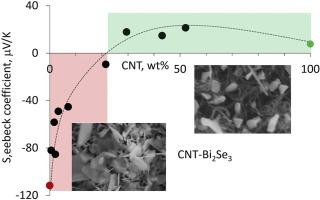Materials Today Energy ( IF 9.0 ) Pub Date : 2020-09-06 , DOI: 10.1016/j.mtener.2020.100526 K. Buks , J. Andzane , K. Smits , J. Zicans , J. Bitenieks , A. Zarins , D. Erts

|
Flexible thermoelectric generators are an emerging trend in the field of waste heat conversion, as well as wearable and autonomous devices. However, the energy conversion efficiency of the state-of-the-art flexible thermoelectric devices is too low for their wide application and commercialization. In this work, n- and p-type multiwalled carbon nanotube (MWCNT)-thermoelectric material hybrid networks that may become a promising building block for the fabrication of flexible thermoelectric devices are presented. The hybrid networks were fabricated by direct deposition of thermoelectric material (Bi2Se3, Sb2Te3) on the MWCNT networks using physical vapor deposition technique. Growth mechanisms of Bi2Se3 and Sb2Te3 on MWCNTs were investigated. The Seebeck coefficient and charge transport properties of MWCNT-Bi2Se3 and MWCNT-Sb2Te3 hybrid networks were studied as function of MWCNT wt% in the networks. Variable-range hopping models were applied for the interpretation of conductance mechanisms in the hybrid networks. The Seebeck coefficients of the MWCNT-Sb2Te3 and MWCNT-Bi2Se3 hybrid networks with low MWCNT wt% were found to be comparable with the Seebeck coefficients of pure inorganic Sb2Te3 and Bi2Se3 thin films. At the same time, flexibility tests of the MWCNT-Sb2Te3 and MWCNT-Bi2Se3 hybrid networks with MWCNT 50% showed no significant increase in the resistance when they were bent to a radius of 5 mm. This makes hybrid networks, presented in this work, the perspective for applications in flexible thermoelectrics as thermoelectric coatings for flexible substrates and fillers for polymers-based composites.
中文翻译:

通过在多壁碳纳米管上直接沉积Bi 2 Se 3和Sb 2 Te 3制备的创新杂化网络的生长机理和相关的热电性能
柔性热电发电机是废热转化以及可穿戴和自主设备领域的新兴趋势。然而,对于它们的广泛应用和商业化而言,现有技术的柔性热电装置的能量转换效率太低。在这项工作中,提出了n型和p型多壁碳纳米管(MWCNT)-热电材料混合网络,这些网络可能成为制造柔性热电设备的有希望的基础。通过使用物理气相沉积技术将热电材料(Bi 2 Se 3,Sb 2 Te 3)直接沉积在MWCNT网络上来制造混合网络。Bi 2 Se的生长机理研究了MWCNTs上的3和Sb 2 Te 3。研究了MWCNT-Bi 2 Se 3和MWCNT-Sb 2 Te 3杂化网络的塞贝克系数和电荷传输性质,作为网络中MWCNT wt%的函数。可变距离跳变模型被用于解释混合网络中的电导机制。发现低MWCNT wt%的MWCNT-Sb 2 Te 3和MWCNT-Bi 2 Se 3杂化网络的塞贝克系数与纯无机Sb 2 Te 3和Bi 2的塞贝克系数相当。硒3薄膜。同时,MWCNT-Sb 2 Te 3和MWCNT-Bi 2 Se 3杂化网络与MWCNT为50%的挠性测试显示,当弯曲成5 mm的半径时,电阻没有明显增加。这使得本工作中介绍的混合网络成为了在柔性热电学中的应用前景,作为柔性基体的热电涂层和聚合物基复合材料的填料。











































 京公网安备 11010802027423号
京公网安备 11010802027423号